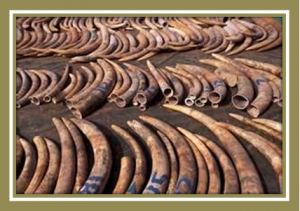News
Latest Lion Aid News
Botswana participated in the 2008/2009 CITES authorized sale of ivory to China and Japan. What happened to the money earned?
Thursday 27th February 2014

Used to conserve elephants? In 2008, four southern African countries (Zimbabwe, Botswana, South Africa and Namibia) were given permission to sell part of their ivory stockpiles to China and Japan. Botswana sent 16,682kg to Japan and 26,488kg to China. From an impeccable source in Botswana, the following additional details have come to light:
These companies do not appear on a quick Google search, but do appear to be independent companies and not State organizations authorized by CITES to import raw ivory. Why is that? Further, the revenue earned from these sales was deposited into a government administered account called the Conservation Trust Fund (CTF). Its primary use is for elephant conservation projects and community projects in the elephant range. The CTF was established specifically in 1999 after the tenth Conference of Parties to the Convention on International Trade on Endangered Species of Wild Fauna and Flora (CITES) held in Zimbabwe. It was at this conference that the elephant population of Botswana, Namibia and Zimbabwe were down-listed to Appendix II with some conditionality for a once-off sale of ivory stocks. Decisions 10.1 and 10.2 at the CoP indicated that all funds accrued from the sale of ivory to Japan, the first recipient of legal ivory, should be deposited into a Trust Fund which would be used exclusively for elephant conservation and development projects for communities living within the elephant range. Hence the Conservation Trust Fund was established to ensure that the proceeds of ALL ivory sales were going to benefit conservation of Botswana’s elephants. This requirement was also maintained for the second round of ivory sales. According to a Botswana Government website “the Fund is administered by a Board of Trustees appointed by the minister of Ministry of Environment, Wildlife and Tourism. It is apportioned in such a way that seventy percent (70%) of the total revenue is ploughed back into elephant conservation and this includes such projects as follows: monitoring of elephant populations movement, water development. These projects will be principally be conducted by the Department of Wildlife and National Parks but may also be extended to private researchers. The remaining thirty percent of the revenue from ivory stock sales goes to Community Development projects. These are the communities that are paying a price of living side by side with elephants. It is anticipated that projects will add value to conservation so that people will better appreciate wildlife as a natural resource.” Since 2008, five Community Based Organizations have benefitted from the CTF with a total funding of $278,621. These were:
This would imply that the balance in the CTF from the 2008 sale alone is about $6,758,089; in other words only a very small part of the money earned has been spent to date. In addition, while the CTF does have an elephant conservation component as well as a community component, it does not appear that ANY funds have been spent on elephant conservation. If the CITES approved sales were to benefit elephant conservation, where is the proof? I would urge Botswana to provide additional information I might not have been supplied with. In addition, I would request similar information from Namibia, South Africa and Zimbabwe. How was your ivory sale money spent? This perhaps particularly relevant because the highly controversial auction to trophy hunt a black rhino held by the Dallas Safari Club generated $350,000 to be placed in Namibia’s Game Products Trust Fund. This was supposed to be earmarked specifically for rhino conservation in Namibia. Transparency breeds confidence. If ivory stockpile sales are not benefiting elephant conservation then there is another very compelling reason not to allow them in the future. Picture credit: news.bbc.uk If you have not already signed up to our mailing list, you can add your name here and keep up to date with our ongoing work and, most importantly, DONATE to support our work to conserve the remaining fragile lion populations. Thank you. Categories: Events/Fundraising, Traditional Medicine, Extinction, Domesticating Animals |
Posted by Chris Macsween at 19:28
No comments have been posted yet.
Add a new comment
Existing user
New user sign up



